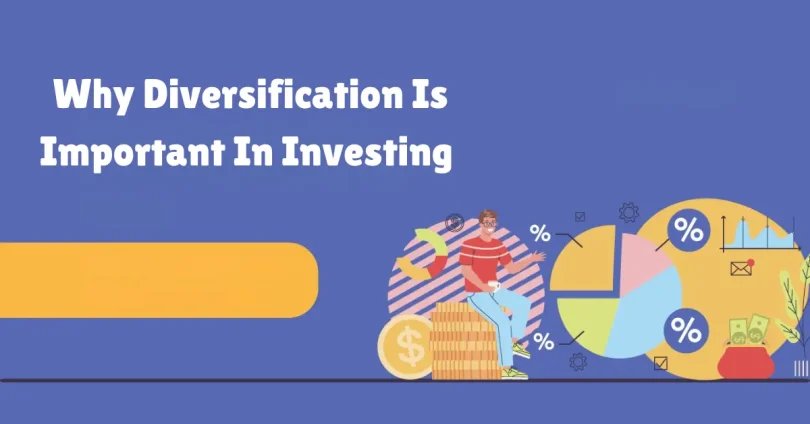If you’ve ever heard the saying, “don’t put all your eggs in one basket,” you already understand the core idea behind diversification. In investing, that “basket” is your portfolio, and the “eggs” are your investments. If all your eggs are in one basket and it drops, you lose everything. But if your eggs are spread out across different baskets, one fall won’t wipe them all out.
That’s exactly what diversification does—it spreads your investments across different assets, industries, and regions. In this article, we’ll break down why diversification is important in investing, how it protects your money, and ways you can apply it to your own portfolio.
What Is Diversification in Investing?

Diversification simply means spreading your money across different types of investments so you’re not overly dependent on one. Instead of putting all your savings into one company’s stock, you might balance it out with bonds, mutual funds, real estate, or even commodities like gold.
Think of it like building a balanced meal: you wouldn’t eat only pizza every day (as tempting as that sounds). To stay healthy, you mix in vegetables, proteins, and grains. Similarly, a balanced investment portfolio mixes riskier, high-reward assets with more stable, steady ones.
Why Diversification Is Important in Investing
Let’s dive into the main reasons investors—both beginners and experts—make diversification a top priority.
1. Reduces Risk
The number one reason why diversification is important in investing is risk management. Imagine putting all your money in one stock. If that company goes bankrupt or faces a huge downturn, your portfolio could collapse. But if you’ve spread your money across multiple assets, one failure won’t sink your entire financial future.
In other words, diversification is your financial safety net.
2. Balances Market Ups and Downs
The market doesn’t move in one direction. At times, technology stocks may be booming while energy companies are struggling—or vice versa. Diversification helps smooth out these ups and downs by ensuring your portfolio isn’t overly dependent on one sector.
This balance provides more consistent returns over time, making your financial journey less stressful.
3. Maximizes Growth Opportunities
No one knows exactly which sector or company will perform best in the future. By diversifying, you increase your chances of benefiting from growth in multiple areas.
- Stocks might deliver high growth.
- Bonds provide steady income and stability.
- Real estate offers long-term value and potential rental income.
- Commodities like gold or oil protect against inflation.
When you combine these, your portfolio doesn’t just survive market changes—it thrives in different economic environments.
4. Protects Against Inflation
Inflation is like a slow leak in your wallet—it decreases the purchasing power of money over time. Some assets, like real estate or commodities, typically perform well during inflationary periods. By having them in your portfolio, you shield your wealth from being eaten away.
This protection is one of the most overlooked reasons why diversification is important in investing.
5. Reduces Emotional Stress
Let’s be real: investing is not just about numbers; it’s also about emotions. Watching your portfolio drop can be nerve-wracking. If you’re only invested in one risky asset, a market downturn can make you panic and sell at the worst possible time.
But with a diversified portfolio, you’re less likely to make rash decisions because you know your wealth is spread out. Diversification provides peace of mind alongside financial stability.
Practical Ways to Diversify Your Investments

Now that we’ve covered the “why,” let’s talk about the “how.” Here are some simple ways to diversify:
- Stocks – Offer high growth potential but also higher risk.
- Bonds – Provide stability and predictable returns.
- Real Estate – Can generate rental income and long-term appreciation.
- Commodities (like gold, silver, or oil) – Hedge against inflation and market volatility.
- Mutual Funds & ETFs – Professionally managed, pre-diversified investments.
- Geographic Diversification – Investing across different countries to reduce risks tied to one economy.
The right mix depends on your age, financial goals, and risk tolerance.
You may also like to read this:
10 Best Personal Finance Tips For Beginners To Start Saving
Personal Finance Vs Corporate Finance: Key Differences
What Is Smart Investing Strategy? Beginner’s Guide
8 Types of Smart Investment Options: Beginner-Friendly Guide
How To Invest In Stocks For Beginners And Grow Your Money
Real-World Examples of Diversification in Action
Sometimes, the best way to understand why diversification matters is to look at history.
1. The Dot-Com Bubble (2000–2002)
In the late 1990s, everyone was investing heavily in tech and internet stocks. When the bubble burst in 2000, many of these companies collapsed. Investors who only held tech stocks lost massive amounts of money. But those with diversified portfolios—holding bonds, real estate, or non-tech stocks—were cushioned from the worst of the crash.
2. The Global Financial Crisis (2008)
When the housing market crashed, real estate and financial stocks took a big hit. Investors who had all their money tied to banks or property lost heavily. But those who diversified into government bonds or commodities saw those assets perform better during the crisis, softening the overall blow.
3. COVID-19 Market Crash (2020)
In early 2020, stock markets dropped dramatically due to uncertainty around the pandemic. But gold prices surged, and some technology stocks quickly recovered as the world shifted online. Investors who had spread their money across multiple assets were able to ride out the turbulence much better than those who were all-in on one industry.
These examples highlight the same lesson: you can’t predict the future, but you can prepare for it by diversifying.
Common Mistakes to Avoid in Diversification
While diversification is powerful, many investors make mistakes that reduce its effectiveness. Here’s what to watch out for:
- Over-Diversifying – Spreading money too thin across too many investments can dilute returns. The goal is balance, not owning “a little bit of everything.”
- Ignoring Correlation – Some assets move in the same direction. For example, owning several tech stocks doesn’t give true diversification. Instead, mix different industries and asset classes.
- Forgetting Global Diversification – If all your investments are in your home country, you’re still exposed to country-specific risks. International investments can add extra protection.
- Not Rebalancing – Over time, some investments will grow faster than others, skewing your portfolio. Regular rebalancing ensures your mix stays aligned with your goals.
How to Build a Diversified Portfolio (Step by Step)
Here’s a simple roadmap if you’re starting out:
- Define Your Risk Tolerance – Are you comfortable with higher risk for higher returns, or do you prefer stability?
- Pick Core Investments – Usually a mix of stocks, bonds, and perhaps real estate or ETFs.
- Add Inflation Protection – Commodities or real estate can protect your money’s value.
- Think Globally – Consider U.S. markets, emerging markets, and international funds.
- Review and Rebalance Annually – Adjust your portfolio as markets shift and as your life goals change.
Final Thoughts
The truth is simple: no one can predict the future of the markets. That’s exactly why diversification is important in investing. It doesn’t eliminate risk completely, but it significantly reduces the chances of a single event wiping out your wealth.
Diversification is like building a strong ship—you can’t control the waves, but you can prepare your vessel to withstand the storm. By spreading your investments across different assets, industries, and regions, you protect yourself while keeping the door open for growth.
So, whether you’re just starting out or already have an investment portfolio, make diversification your priority. It’s not about quick wins—it’s about long-term financial security, steady growth, and peace of mind.
FAQs
1. What does diversification mean in investing?
Diversification means spreading your money across different types of investments, such as stocks, bonds, real estate, or commodities, instead of putting everything into one asset. This helps reduce risk and balance returns.
2. Why is diversification so important in investing?
Diversification is important in investing because it reduces the risk of losing everything if one investment performs poorly. It balances ups and downs in the market and provides more consistent long-term growth.
3. Does diversification guarantee profits?
No, diversification does not guarantee profits. However, it helps limit losses and provides stability. Think of it as a safety net—it won’t eliminate risk, but it makes investing less risky.
4. How many investments do I need to be diversified?
There’s no magic number, but a good rule of thumb is to invest across multiple asset classes and industries. Mutual funds and ETFs are great tools because they include dozens or even hundreds of investments in one.
5. Can you over-diversify your portfolio?
Yes. If you spread your money too thin across too many assets, your returns can become diluted. The key is balance—enough diversification to reduce risk, but not so much that growth potential disappears.




